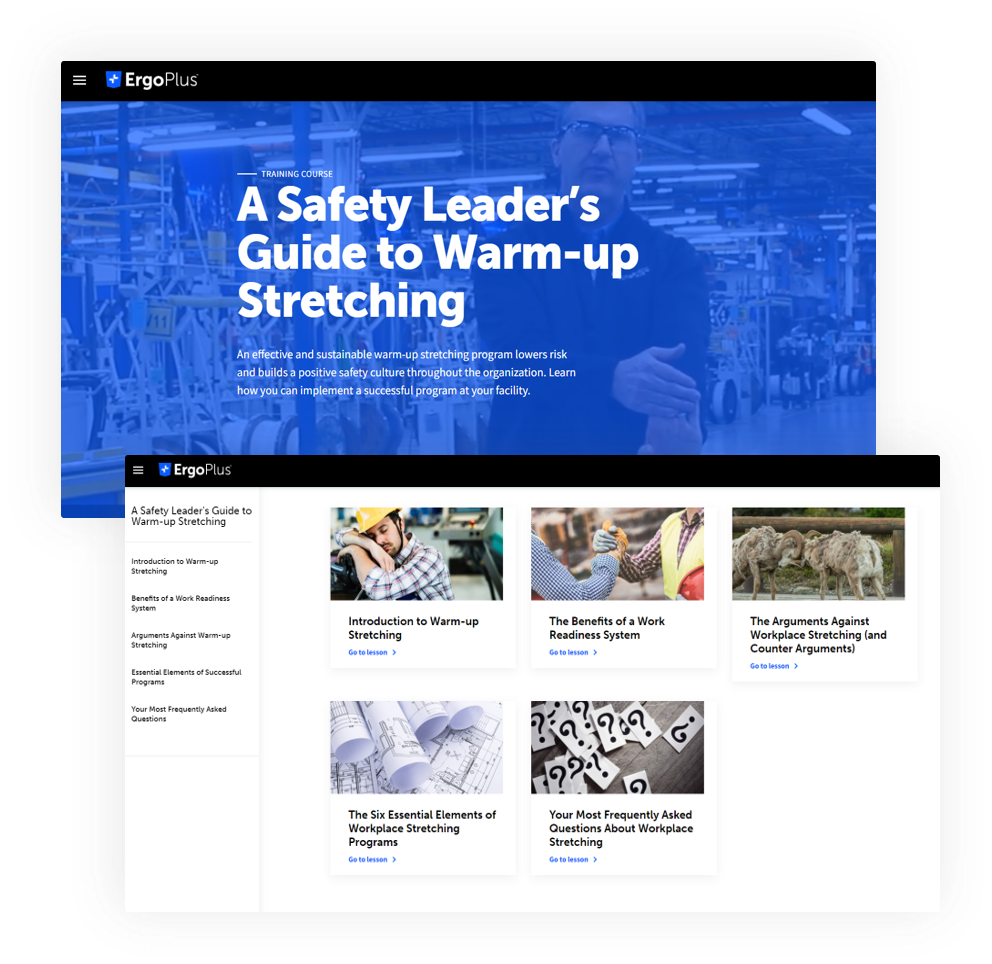Making sure your team members are physically ready for work reduces injury risk and promotes a health, safety and team culture.
What’s the first thing you’ll do before your Saturday morning tennis match?
I’ll bet it’s the same thing you do after a long car ride.
You’ll stretch.
You’ll move and loosen up and warm up your muscles. And you’ll feel great after you do it.
Warming up your body and stretching are very natural things to do, and there are many benefits to doing them.
Just as you benefit from stretching and warm-up exercises in your day-to-day life, companies and their team members both benefit from a Work Readiness program consisting of stretching and warm-up exercises, which helps prevent Musculoskeletal Disorders (MSDs).
MSDs are common and costly – to the tune of roughly $50 billion a year for companies (BLS), and cause unnecessary pain and suffering for your people.
It’s very clear that prevention is the answer. Proactive prevention is always better than reactive treatment – everybody wins in the prevention scenario and nobody wins with painful surgery, medication, lost work days, a ruined safety culture and a fortune spent on preventable injuries.
First, the importance of a complete prevention strategy
In our experience, companies often react to a rise in musculoskeletal injuries by searching for a magic “silver bullet” that will prevent them. They might conduct an ergonomic assessment or have a training session or institute pre shift stretching.
These are all good actions to take, but a common mistake is to expect one of these tactics alone to produce long-term health and safety gains.
Given that human beings are multi-dimensional and the interaction between people, equipment and work processes is complex, there is no “silver bullet” to prevent soft tissue injuries.
Risk factors that cause these injuries are numerous and many different problems can arise over the course of time to contribute to them, so it’s often difficult to determine the exact cause when an injury does occur. Without identifying the underlying causes of the injury, it’s impossible to put the correct control measures in place.
You don’t need a silver bullet. You don’t need to reactively implement one or two tactics and hope for the best. Rather, you need a complete and well thought out prevention strategy designed for long-term health and safety gains.
The smart way to prevent MSDs is to proactively implement a comprehensive process that reduces all causative risk factors. Safety leaders that do this will prevent musculoskeletal injuries in a consistent and predictable way.
Following is an outline of the elements of a complete Musculoskeletal Disorder (MSD) prevention process.
Workplace Ergonomics
Ergonomics is the science of designing the workplace to fit within the capabilities and limitations of team members. The goal is to make sure the work fits the worker, thereby reducing injury risk and promoting safety, productivity and quality of work.
The ergonomics process identifies and controls risk factors related to the workplace. Stretching and warm-up exercises do not replace an ergonomics improvement process – they enhance it.
Education and Training
Education and training programs develop the knowledge and skills of your team members. Ergonomics, proper body mechanics, proper work technique and good health/hygiene habits all need to be taught in your education and training programs.
Educated decisions and actions by team members require education and training to develop team member’s knowledge and skills. Stretching and warm-up exercises do not replace team member education and training – they enhance it.
Early Intervention
Early intervention is a proactive way to discover early warning signs of MSDs and put control measures in place to prevent an injury from occurring. Team members are encouraged to report early warning signs (excessive fatigue and discomfort) of MSDs. When the early report is received, a qualified professional should conduct an early intervention consultation to identify root causes and consult the team member on injury prevention best practices (work readiness and work recovery methods).
Early intervention is a vital tactic that should be included in your MSD prevention strategy. Stretching and warm-up exercises do not replace an early intervention process – they enhance it.
The physiology of stretching and warm-up exercises
Stretching is a vital part of a healthy fitness regimen. Pre-shift stretching and warm-up exercises reduce the risk of musculoskeletal injuries by reducing fatigue, improving muscular balance and posture, and improving muscle coordination.

Stretching Reduces Fatigue
- Stretching increases blood supply and nutrients to joint structures and soft tissues.
- Stretching increases soft tissue temperature and allows for greater elasticity of tissues.
- Stretching increases joint synovial fluid (lubricant for bones and articular cartilage) that allows greater range of motion and reduces joint degeneration.
- Stretching increases a joint’s ability to move through a greater range of motion with less energy required to do so.
- Stretching decreases tightness and resistance in tendons and muscles.
Stretching Improves Muscular Balance and Posture
- Soft tissue structures often adapted poorly to effects of gravity and poor postural habits.
- Stretching realigns soft tissue structures, thus reducing effort to achieve & maintain good posture in activities of daily living.
Stretching Improves Muscle Coordination
- Stretching enhances nerve impulse velocity (the time it takes an impulse to travel to the brain and back to the muscle).
- Stretching helps opposing muscle groups work in a more coordinated fashion.
Promoting a health, safety and team culture
Instituting a Work Readiness System promotes a health, safety and team culture day in and day out.
In other words, the Work Readiness System works hard for you. Every day your team members come to work, they are reminded that you put their health and safety above everything else. You provided them the precious time to prepare their body and mind for work. You care about them and you care for them.
Companies across the U.S. are facing an employee engagement problem. This is partially due to the fact that many employees don’t believe the company they work for has their best interest in mind.
So let’s call them “team members” because they are a part of your team. And let’s make sure their bodies and minds are ready for work – after all, taking care of your people is also taking care of your business – and that’s priceless.
Workplace stretching and warm-up series
This is the second post in our series on workplace stretching and warm-up programs.
Catch up on the first post here: Workplace Stretching and Warm-up: Are Your Team Members Ready for Work?
Free Training: A Safety Leader’s Guide to Warm-up Stretching
This post is part of a free training course we offer on warm-up stretching programs. Enter your email address below for access to the full training.


